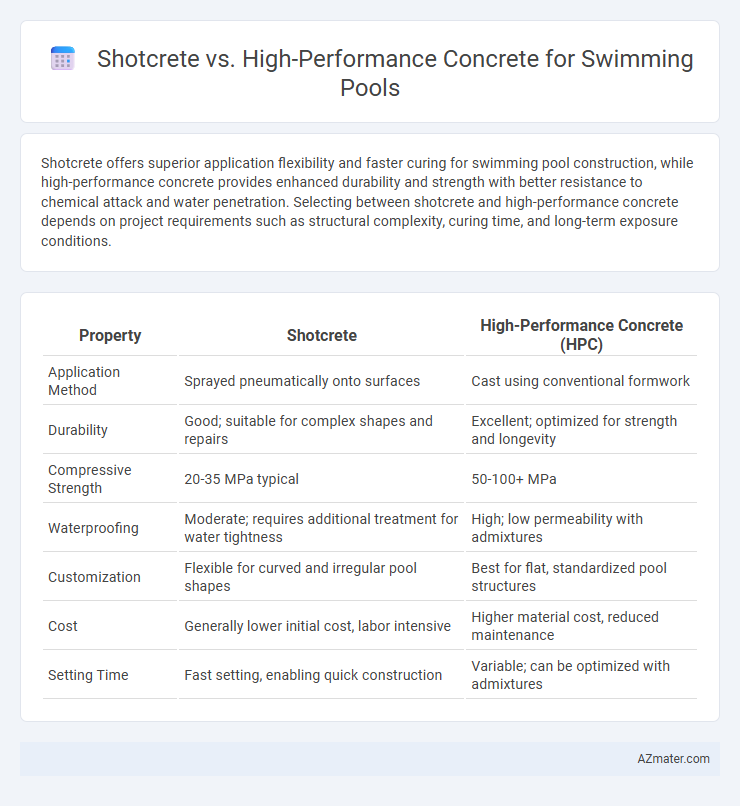Shotcrete offers superior application flexibility and faster curing for swimming pool construction, while high-performance concrete provides enhanced durability and strength with better resistance to chemical attack and water penetration. Selecting between shotcrete and high-performance concrete depends on project requirements such as structural complexity, curing time, and long-term exposure conditions.
Table of Comparison
| Property | Shotcrete | High-Performance Concrete (HPC) |
|---|---|---|
| Application Method | Sprayed pneumatically onto surfaces | Cast using conventional formwork |
| Durability | Good; suitable for complex shapes and repairs | Excellent; optimized for strength and longevity |
| Compressive Strength | 20-35 MPa typical | 50-100+ MPa |
| Waterproofing | Moderate; requires additional treatment for water tightness | High; low permeability with admixtures |
| Customization | Flexible for curved and irregular pool shapes | Best for flat, standardized pool structures |
| Cost | Generally lower initial cost, labor intensive | Higher material cost, reduced maintenance |
| Setting Time | Fast setting, enabling quick construction | Variable; can be optimized with admixtures |
Introduction to Swimming Pool Construction Methods
Shotcrete and high-performance concrete are two widely used materials in swimming pool construction, each offering distinct benefits for durability and structural integrity. Shotcrete is applied by spraying a high-strength concrete mixture at high velocity, enabling efficient layering and shaping, ideal for complex pool geometries. High-performance concrete, characterized by enhanced compressive strength and reduced permeability, provides long-lasting resistance to water infiltration and chemical erosion, making it a preferred choice for swimming pool shells requiring superior durability.
What is Shotcrete?
Shotcrete is a method of applying concrete or mortar projected at high velocity onto a surface, commonly used in swimming pool construction for its rapid application and excellent adhesion to complex shapes. This technique allows for dense, durable layers that form the structural shell of pools, often utilizing a dry-mix or wet-mix process for flexibility and strength. Compared to conventional high-performance concrete, shotcrete enables faster construction times and superior form-fitting properties, essential for the curved and irregular contours of swimming pools.
What is High-Performance Concrete?
High-performance concrete (HPC) is a type of concrete engineered to possess superior strength, durability, and workability compared to conventional concrete, making it ideal for swimming pool construction. HPC incorporates advanced materials like silica fume, fly ash, and chemical admixtures to enhance its resistance to water penetration, chemical attack, and freeze-thaw cycles. This specialized composition ensures a longer lifespan and reduced maintenance for swimming pools exposed to constant moisture and environmental stress.
Key Material Properties Comparison
Shotcrete offers superior adhesion and rapid setting time, making it ideal for complex swimming pool shapes and quick project turnaround. High-performance concrete provides enhanced compressive strength, durability, and resistance to chemical attack, ensuring long-term structural integrity in pool environments. Both materials exhibit low permeability, but high-performance concrete excels in minimizing water ingress and chloride penetration, crucial for pool longevity.
Strength and Durability Analysis
Shotcrete offers rapid application and strong initial bonding, making it suitable for complex swimming pool shapes, while high-performance concrete (HPC) provides superior compressive strength exceeding 10,000 psi and enhanced durability due to optimized mix designs and additives like silica fume. HPC's low permeability significantly reduces water and chemical ingress, extending the pool structure's lifespan and resisting corrosion and freeze-thaw cycles. Comparative studies indicate that while shotcrete delivers adequate strength for standard pools, HPC outperforms in long-term structural integrity and resistance against environmental degradation.
Construction Process: Shotcrete vs High-Performance Concrete
Shotcrete offers a faster construction process for swimming pools due to its sprayed application method, which enables quick layering and shaping of complex designs without extensive formwork. High-performance concrete requires precise mixing and placement in forms, often necessitating longer curing times to achieve its superior strength and durability. Shotcrete's adaptability on-site contrasts with the more controlled, time-intensive procedures needed for high-performance concrete installations.
Water Resistance and Crack Prevention
Shotcrete offers superior water resistance by creating a dense, impermeable layer that minimizes water infiltration, ideal for swimming pool shells exposed to constant moisture. High-performance concrete enhances crack prevention through its optimized mix design, incorporating supplementary cementitious materials and admixtures that improve tensile strength and durability. Combining shotcrete application with high-performance concrete properties ensures maximum structural integrity and longevity for pools under hydrostatic pressure and thermal stress.
Cost Implications and Budget Considerations
Shotcrete offers cost advantages for swimming pool construction due to reduced labor and faster application times compared to traditional casting methods, making it ideal for budget-conscious projects. High-performance concrete, while more expensive upfront due to advanced materials and additives, provides enhanced durability and longer service life, which can lower maintenance and repair costs over time. Selecting between shotcrete and high-performance concrete requires balancing initial budget constraints with long-term financial benefits related to pool longevity and upkeep.
Maintenance and Longevity Factors
High-performance concrete offers superior durability and resistance to chemical deterioration, reducing maintenance needs for swimming pools compared to shotcrete, which is more prone to surface cracking and requires periodic sealing. The dense microstructure of high-performance concrete enhances longevity by minimizing water permeability and chloride ingress, key factors that contribute to corrosion of embedded reinforcing steel. Shotcrete's faster application benefits initial construction speed but may lead to increased long-term maintenance costs due to its lower resistance to freeze-thaw cycles and abrasion.
Choosing the Best Concrete Solution for Your Pool
Shotcrete offers rapid application and superior bond strength, making it ideal for curved or complex pool shapes, while high-performance concrete provides enhanced durability, low permeability, and higher compressive strength for long-lasting structural integrity. Selecting the best concrete solution depends on factors such as pool design complexity, environmental exposure, and maintenance requirements. For highly customized pools exposed to harsh conditions, high-performance concrete delivers optimal resistance to chemicals and freeze-thaw cycles, whereas shotcrete is preferred for faster construction and flexibility in shaping.

Infographic: Shotcrete vs High-performance Concrete for Swimming Pool
 azmater.com
azmater.com